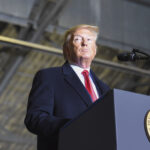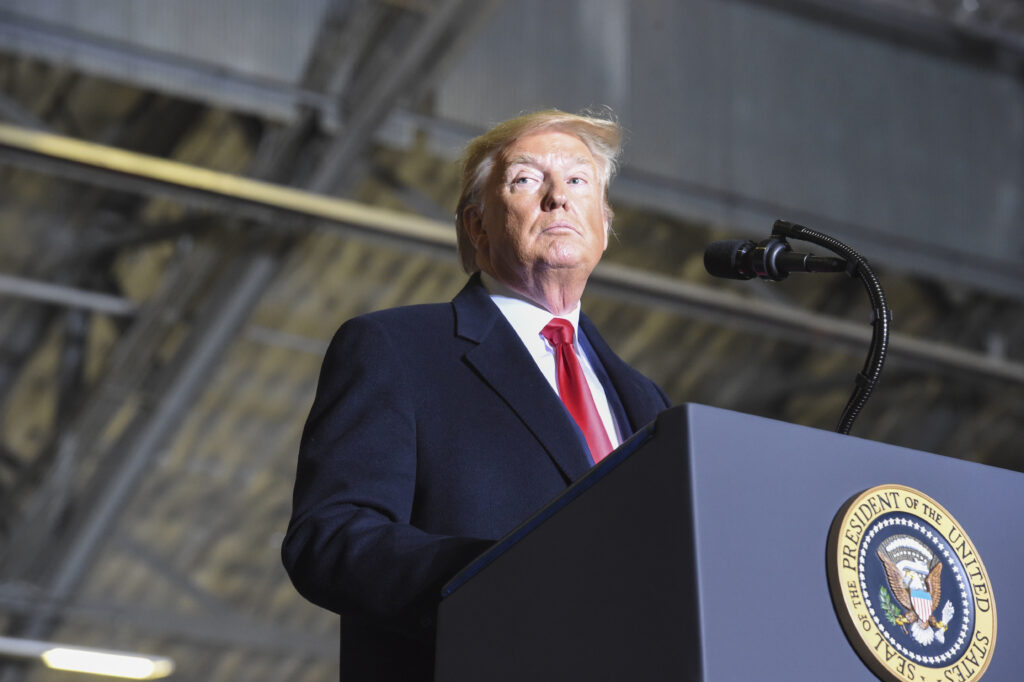
 Source: U.S. Air Force
Source: U.S. Air ForceDonald Trump’s return to the White House, coupled with Republican control of Congress, is set to reshape U.S. defense policy. While many defense modernization programs will remain on track, a second Trump term could result in shifts to defense spending, strategy, and other military priorities, with an emboldened Trump potentially implementing controversial policies more quickly.
Key Strategic Issues
A key flashpoint in Trump’s emerging defense agenda is Ukraine. The former president has criticized ongoing U.S. security assistance to Kyiv and vowed to bring the war to an abrupt end, though he has provided no details on how this would be accomplished. Trump could pressure Ukraine to cede territory or make other concessions, though Kyiv refuses to recognize Russian control of Ukrainian land. He may also press NATO to provide additional resources for Ukraine. Nevertheless, if Trump stands by his previous statements, Ukraine could see a reduction in U.S. aid. Security assistance for Ukraine has helped drive recent DoD budget increases, and reducing or eliminating aid could briefly lower overall spending unless offset by increases elsewhere in the budget.
These increases could come in the form of additional funding for capabilities needed for great power competition, particularly against China. Bipartisan concern over China’s military modernization could drive continued support for investment in long-range fires, missile defense, and a larger Navy, to help bolster Indo-Pacific deterrence. Trump has also been a vocal supporter of Israel and recently told Israeli Prime Minister Benjamin Netanyahu to do what he needs to against Hamas and Hezbollah. The U.S. will likely continue to funnel military aid to Israel, but Trump will face a tense situation in the Middle East when he begins his second term.
Concerns over China and support for Israel are set against a backdrop of Trump’s broader opposition to foreign conflicts, which may lead to a more isolationist U.S. and follow-on impacts on force structure or overseas deployments. It’s also uncertain how a Trump administration would respond to a potential Chinese invasion of Taiwan or Russian aggression against NATO allies.
Defense Spending: Rhetoric vs. Reality
Trump pledged historic military investments, but consistent long-term growth remains uncertain. In his first term, Trump took quick action by proposing a $30 billion defense supplemental during the FY17 budget process and followed up with an FY18 supplemental request that included $4 billion for missile defense programs. At the time, government spending was restricted by the Budget Control Act (BCA), but emergency supplemental bills could be used to bypass spending limits. In FY20, Trump also proposed funneling nearly $100 billion in base budget priorities into war coffers to circumvent the spending caps, but Congress blocked the proposal.
Despite BCA caps, the military averaged 4% annual budget growth under Trump, but his final spending plans proposed zero real growth over the Future Years Defense Program. Trump won’t have to deal with the BCA caps that restricted spending during his first term, but he will have to accommodate the 60-vote threshold to get budget proposals through the Senate.
Under Biden, the Democratic-led Senate was already supportive of higher defense spending, but proposals to gut domestic spending in favor of defense will struggle to get through the Republican-led chamber without a supermajority. Trump, as well as some lawmakers in both parties, have occasionally argued for eliminating the filibuster, which in this case would make it easier for Republicans to dramatically reduce domestic spending while simultaneously bolstering military investment. So far, the Senate has held off against abandoning the filibuster. The GOP has also struggled with intraparty fighting in recent years, resulting in the ouster of House Speaker Kevin McCarthy (R-Calif.) last year, but that dynamic could shift with Trump back in the White House. It remains to be seen if Trump will tilt the scales in the ongoing battle between deficit and defense hawks, particularly as he aims to implement tax cuts that could cost trillions of dollars.
The Pentagon still saw strong budget growth during the Biden administration, which was driven largely by Congressional plus-ups for the base budget and supplemental funding requests from the White House for Ukraine and other matters. For context, Biden requested $895 billion in base national security funding in FY25, while Trump’s final budget proposal would have resulted in around $808 billion by FY25. Notably, Trump’s projections don’t account for the recent inflation spike, which resulted in some budget growth to offset higher costs. Regardless, if Trump proposes a larger defense budget, the move would reflect a continuation of recent budget growth for the Pentagon, rather than a dramatic shift in topline spending. What remains to be seen is how strong that growth will be.
Investment Priorities
If Trump stands by his word to boost military investment, where will the money go? His final budget proposal, which was released after Joe Biden won the 2020 election, would have invested more heavily in growing the Navy fleet while scaling back overseas operations and reducing Army end strength.
However, the Heritage Foundation’s Project 2025, which could serve as a roadmap for some of the administration’s priorities, calls for increased investment in virtually all areas of the military. Trump distanced himself from Project 2025 on the campaign trail, but the plan offers insights into conservative thinking on programs and policies throughout the Pentagon. Project 2025 includes some of the following recommendations:
- Army – Accelerate the service’s top six modernization efforts: long-range precision fires, next-generation combat vehicles, Future Vertical Lift, networks, air defense systems, and soldier lethality; increase the Army by 50,000 troops
- Navy – Pursue a 355+ ship fleet, unmanned systems, long-range strike capabilities, and faster munitions procurement
- Marine Corps – Continue Force Design 2030 transformation initiative; buy additional HIMARS batteries and retire M777 howitzers; and buy more unmanned aerial systems (UAS) and counter-UAS capabilities
- Air Force – Increase production of F-35s and B-21 bombers, while advancing the Next Generation Air Dominance (NGAD) program; increase airlift and aerial refueling capabilities; buy higher quantities of mid-range weapons; double the EC-37B fleet
- Space Force – Expand offensive capabilities and space control capabilities, including in cislunar space (the space that extends from geosynchronous orbit to the moon)
Trump has also voiced support for broader domestic missile defense capabilities, but his suggestion for national coverage from an Iron Dome-like system is unrealistic. He has also discussed modernizing and expanding the nuclear arsenal. Many of these goals, particularly expanding munitions production and growing the Navy fleet, would require continued investment in growing the domestic industrial base. Trump will likely scale back Pentagon climate initiatives, but infrastructure hardening and port adaptations remain essential against storms and rising sea levels.
Leadership Shakeup
Trump ended his first term in office at odds with segments of his own administration’s leaders. A significant number of officials that worked closely with the president refused to endorse his second run for the White House, including his own vice president, secretary of defense, chairman of the joint chiefs of staff, national security advisor, and White House chief of staff. Statements from some of these officials acknowledged Trump’s clear lack of respect for constitutional norms, his disdain for limits on executive power, and his authoritarian tendencies. Trump will increasingly surround himself with loyalists, reducing internal opposition. For example, Trump’s campaign was laden with rhetoric labeling his political opponents as enemies of the state that pose a greater threat than China, and he even suggested using the military against these internal threats.
Trump’s second term is likely to usher in a dramatic overhaul of Pentagon leadership. He nominated Army veteran and Fox News commentator Pete Hegseth as Secretary of Defense. Despite a lack of experience, Hegseth is ideologically aligned with Trump against diversity efforts in the Pentagon and has also spoken out against the use of women in combat. Trump’s team has also floated the idea of purging generals that support diversity programs or other cultural issues on Trump’s radar, which could lead to the ousting of Chairman of the Joint Chiefs of Staff, Gen. CQ Brown, Jr. Widespread leadership changes could have unforeseen impacts on recruiting or operational readiness. Trump’s cabinet picks must still go through the Senate nomination process, but he is urging the use of recess appointments to bypass Senate approval.
With sweeping policy shifts, leadership changes, and potential realignments in global strategy, Trump’s second term could reshape U.S. defense priorities – leaving allies, adversaries, and the Pentagon itself bracing for the impact.
Originally published What Trump’s Second Term Could Mean for U.S. Defense Policy on by https://dsm.forecastinternational.com/2024/11/19/what-trumps-second-term-could-mean-for-u-s-defense-policy/?utm_source=rss&utm_medium=rss&utm_campaign=what-trumps-second-term-could-mean-for-u-s-defense-policy&utm_source=rss&utm_medium=rss&utm_campaign=what-trumps-second-term-could-mean-for-u-s-defense-policy at Defense & Security Monitor
Originally published Defense & Security Monitor

